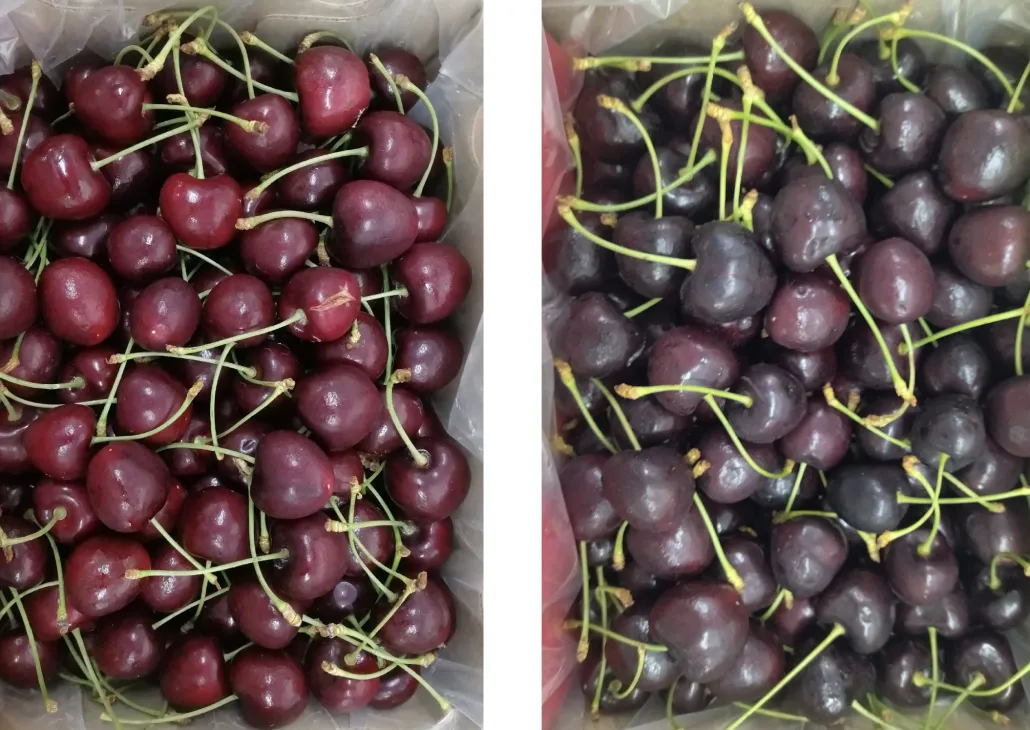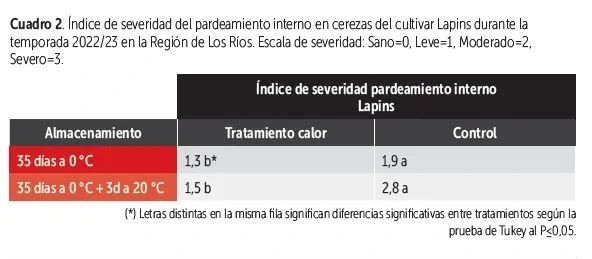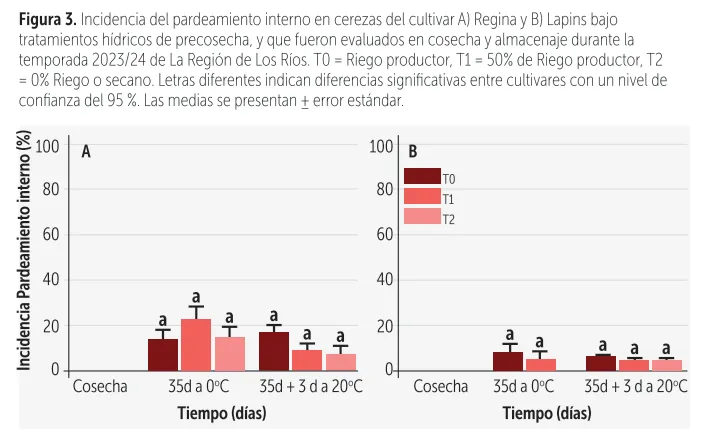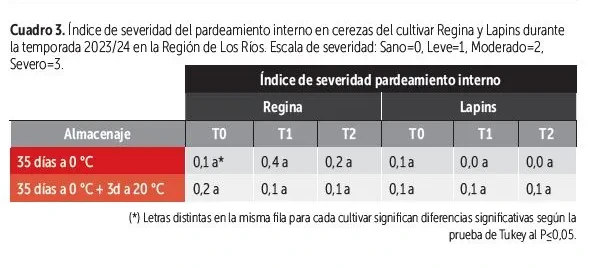More common than one might think, internal browning of southern cherries, regardless of the location, size, and technological level of the orchard, is a widespread issue. A study by UACh using thermal treatments, though not a practical procedure for the fruit industry, has provided better insights into the physiology of this disorder.
Internal browning, a physiological disorder that affects the quality of cherries, is a major defect occurring during post-harvest (Palacios-Peralta et al., 2022). The incidence of internal browning has increased in recent years due to longer travel times to export destinations.
Indeed, Regina is the third most exported variety from Chile, accounting for 19% of the total volume traded and a 23% increase in the volume sold during the recent 2023/24 season compared to the previous one (iQonsulting, 2024).
 Image 1: Cherry cv. Regina.
Image 1: Cherry cv. Regina.
The southern macro-zone (Araucanía, Los Ríos, and Los Lagos regions) accounts for 5.2% of the country's cherry exports, where commercial cherry production by large growers and exporters coexists with that of family farming. However, regardless of orchard size, cherries from the southern region face internal browning issues.
In this context, the Universidad Austral de Chile conducted several studies during the 2021/22, 2022/23, and 2023/24 seasons in three orchards located in the Los Ríos region to evaluate the incidence of internal browning in southern cherries.
The climate corresponds to a temperate maritime climate (Cfb) according to the Köppen climatic classification. The Lapins cultivar trees were grafted on Colt rootstock in a planting layout of 5×3 m, while the Regina and Kordia cultivars were grafted on Gisela®6 rootstock in a layout of 4×1.8 m, all with a central leader system.
The fruits were harvested at a mahogany color stage (UC scale 3.5) from four randomly selected trees per variety, further divided into four sections per tree. The fruits from each section were stored for 40 days (d) at 0°C in 1-kg PET containers sealed with a polypropylene film in a modified atmosphere (5% CO2 and 15% O2).
The results of this first season showed that Regina was the most affected cultivar by internal browning, with an incidence above 70% in both storage periods. The severity of internal browning was assessed on a scale: Healthy=0, Mild=1, Moderate=2, and Severe=3 (Image 1). The results showed that after 40 days at 0°C, Regina, Kordia, and Lapins exhibited a low severity index.
 Image 1: Incidence of internal browning in Regina, Kordia, and Lapins cherries stored during the 2021/22 season in the Los Rios region. Different letters indicate significant differences between treatments at a 95% confidence level. Averages are presented +/- standard error.
Image 1: Incidence of internal browning in Regina, Kordia, and Lapins cherries stored during the 2021/22 season in the Los Rios region. Different letters indicate significant differences between treatments at a 95% confidence level. Averages are presented +/- standard error.
In the second season (2022/23), only the Lapins cultivar, planted in 2012 in a commercial orchard located in the Tralcao locality on Pelchuquín soil series, was evaluated. The climate corresponds to the same classification as the previous orchard but with a higher incidence of frost. The Lapins cultivar trees were on F12 rootstock with a central leader training system.
During this second season, the effect of a pre-harvest thermal treatment on internal browning was studied. Three chambers of 2.6 x 2.6 x 2.8 m made of transparent polyethylene were installed.
The thermal treatment was applied from the green fruit phenological stage until commercial harvest. Three untreated control trees were also evaluated. All trees, both treated and controls, were selected randomly. The air temperature inside the chambers was approximately 4°C higher than outside, and relative humidity (RH) was 15-20% higher.
The harvested fruits, mahogany in color (UC scale 3.5), were stored for 35 days at 0°C + 3 days at 20°C. After each storage period, the incidence of internal browning was assessed. Results for the 2022/23 season on the Lapins cv. (Image 2) showed that the incidence of internal browning was higher in the control treatment than in the thermal treatment.
 Image 2: Incidence of internal browning during storage of Lapins cherries treated thermally from green to commercial harvest during the 2022/23 season in the Los Rios region. Different letters indicate significant differences between treatments at a 95% confidence level. Averages are presented +/- standard error.
Image 2: Incidence of internal browning during storage of Lapins cherries treated thermally from green to commercial harvest during the 2022/23 season in the Los Rios region. Different letters indicate significant differences between treatments at a 95% confidence level. Averages are presented +/- standard error.
After 35 days at 0°C, fruits from the control treatment showed an incidence of ~50% affected fruits compared to ~20% in the thermal treatment. After 35 days + 3 days at 20°C, the control group had an incidence of 100% (all fruits affected), while the thermal treatment had a lower incidence of ~80%.
Regarding the severity index for the 2022/23 season (Table 2), the control fruits were more affected, showing an index of 1.9 and 2.8 after 35 days of storage at 0 °C and 35 days + 3 days at 20 °C, respectively, compared to the heat-treated fruits which had a severity of 1.3 and 1.5, respectively.
 Table 2: Severity index of internal browning in Lapins cherries during the 2022/23 season in the Los Ríos region. Severity scale: healthy=0, mild=1, moderate=2, severe=3.
Table 2: Severity index of internal browning in Lapins cherries during the 2022/23 season in the Los Ríos region. Severity scale: healthy=0, mild=1, moderate=2, severe=3.
Finally, during the 2023/24 season, the Regina and Lapins cultivars were studied in a commercial orchard in the locality of Tralcao, without cover or roof. The Regina cultivar was on Gisela®6 rootstock, and Lapins on MaxMa14, both planted in 2004 with a 4×2.5 meter layout.
In this third season, the effect of water restriction on the incidence of internal fruit browning was studied. Three irrigation treatments were tested: T0 = grower irrigation, T1 = grower irrigation at 50%, T2 = 0% irrigation or rainfall, which, given the climatic conditions of the area, could be effectively applied between the green fruit stage and commercial harvest. Soil moisture at 15 and 40 cm depths, evaluated with TEROS 10 probes (Meter Inc., WA, USA), confirmed differences in soil water content.
Harvesting, storage, and subsequent evaluation of internal browning were performed as in previous seasons. Image 3 shows that browning was significantly lower in Regina and Lapins compared to orchards from previous seasons.
 Image 3: Incidence of internal browning in cherries of the cultivars A) Regina and B) Lapins subjected to pre-harvest water treatments and evaluated at harvest and storage during the 2023/24 season in the Los Ríos region. T0 = grower irrigation, T1 = grower irrigation at 50%, T2 = 0% irrigation or rainfall. Different letters indicate significant differences between cultivars at a 95% confidence level. Averages are presented +/- standard error.
Image 3: Incidence of internal browning in cherries of the cultivars A) Regina and B) Lapins subjected to pre-harvest water treatments and evaluated at harvest and storage during the 2023/24 season in the Los Ríos region. T0 = grower irrigation, T1 = grower irrigation at 50%, T2 = 0% irrigation or rainfall. Different letters indicate significant differences between cultivars at a 95% confidence level. Averages are presented +/- standard error.
Incidence levels remained low, between 10 and 20% in both cultivars. There were no statistically significant differences among the water restriction treatments. In terms of severity, both cultivars showed low values for this disorder and exhibited no differences between treatments (Table 3).
 Table 3: Severity index of internal browning in Regina and Lapins cherries during the 2023/24 season in the Los Ríos region. Severity scale: healthy=0, mild=1, moderate=2, severe=3.
Table 3: Severity index of internal browning in Regina and Lapins cherries during the 2023/24 season in the Los Ríos region. Severity scale: healthy=0, mild=1, moderate=2, severe=3.
Source: Redagrícola
Images: Redagrícola
Francisca Coye, Catalina Cuevas, Pamela Artacho, Carolina Contreras
Universidad Austral de Chile
Cherry Times - All rights reserved


















